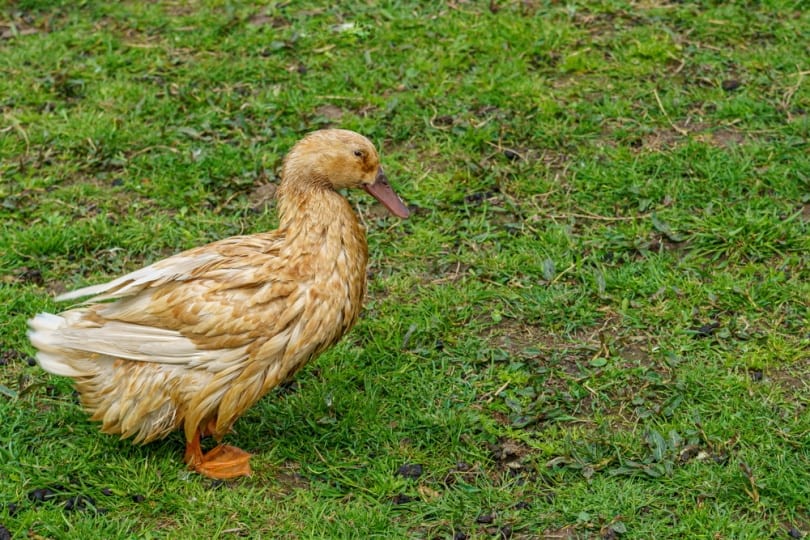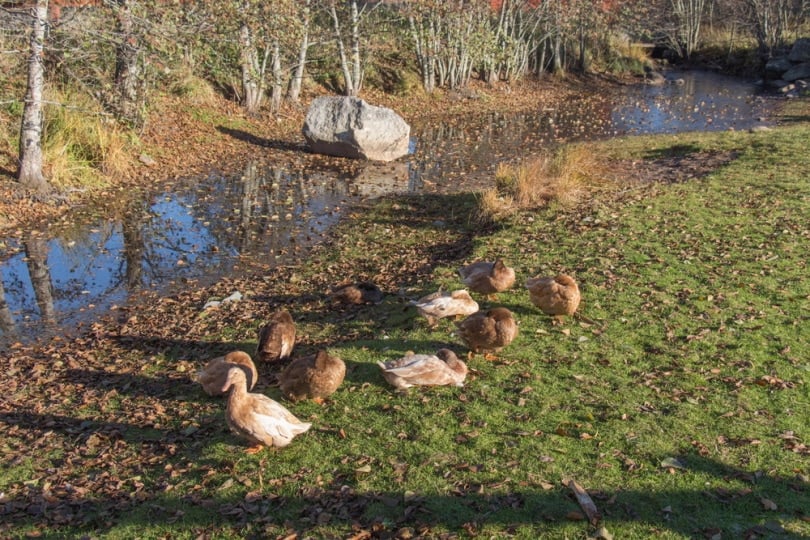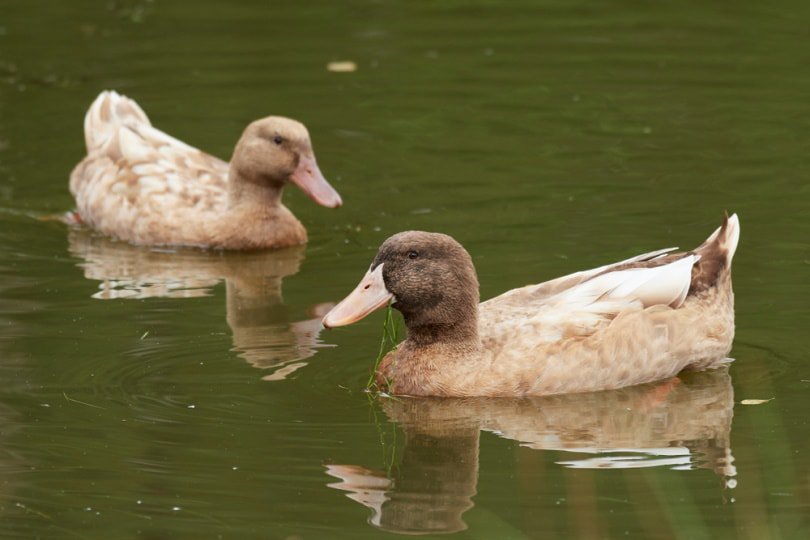The Swedish yellow duck is an intentional combination of three different domestic species. Even though these ducks are relatively rare, they are sought after because of their calm disposition and triple-purpose use.
The Swedish yellow duck might be challenging to find, depending on where you live. But if you are lucky enough to get a few of these beauties at a local hatchery or breeder, they are generally easy to keep and make fantastic pets. Let’s learn more.

Quick Facts About Swedish Yellow Ducks
| Breed Name: | Svensk Gul Anka (Swedish Yellow Duck) |
| Place of Origin: | Sweden |
| Uses: | Triple purpose |
| Drake Size: | 7–8 pounds |
| Duck Size: | 6.5–7.5 pounds |
| Color: | Yellow, brown |
| Lifespan: | 8–12 years |
| Climate Tolerance: | Cold hardy |
| Care Level: | Moderate |
| Production: | Moderate |
| Temperament: | Calm |
Swedish Yellow Duck Origins
The Swedish Yellow Duck was developed in Skane province in Sweden by Mans Eriksson. There is a bit of debate on the actual ducks used to form this yellow waterfowl, but it’s speculated that they have Blue Swedish, Khaki Campbell, and some local breed of white duck.
Swedish Yellow Ducks were surprisingly common in the 1930s. Developed in the 20th century, these purposeful waterfowl wound up filling folks’ farms across Sweden. It wasn’t until the 1950s that they started becoming what we would consider a rare duck breed.
Today, they have only been verified to still exist in their homeland of Sweden.

Swedish Yellow Duck Characteristics
Swedish Yellow Ducks are known for their wonderful dispositions, making fantastic pets for kids and adults alike. You could easily use them for school projects and other formulated activities because they’re effortless to handle and almost entirely flightless.
The Swedish Yellow Duck spends most of its day toddling about the barnyard. They love to have a water source nearby, as all waterfowl do. Males might show aggression toward other ducks during mating season but should be docile otherwise.
There is no denying that this duck is hearty and moderately active to promote excellent foraging capabilities.
Uses
You get the best of all worlds when choosing the Swedish Yellow Duck. These birds are good for any use that you can imagine, including ornamental and egg and meat production. They truly are a triple-purpose breed!
Since they are relatively rare, we recommend not using them for meat if you can help it. Plenty of other sizable meat ducks on the market would work better (though they do make robust and tasty meat birds).
These ducks lay large white eggs, though sometimes they can have a bluish or grayish hue. Generally, the ducks can lay up to 130 eggs annually.
Due to their Blue Swedish heritage, these ducks go broody often and make excellent mothers. Even if they don’t brood their own batch of eggs, they will be happy to mother other ducks—and even chicken eggs!

Appearance & Varieties
As the name implies, most Swedish Yellow Ducks are yellow in color. That said, the males have brown heads, making them sexually dimorphic to females. Males also slightly outweigh their female counterparts by a pound or two.
The term yellow is loosely used for this breed. If you look closely, you’ll notice that they are more buff to yellowy-brown in color. The appearance was achieved by combining Swedish ducks, Khaki Campbells, and white ducks.
Population/Distribution/Habitat
Swedish Yellow Ducks have limited availability in today’s world.
- Population: In their homeland of Sweden, all Swedish ducks measure somewhere in the ballpark of 130 breeding birds. Not all of these include Swedish Yellow Ducks, as there are several Swedish waterfowl. No definitive numbers are available per our research.
- Distribution: Although Swedish Yellow Ducks once had a wide range of availability, they are now exclusively in Sweden. So, unless you’re a Swedish native, you’ll have next to no luck locating these buff beauties.
- Habitat: Like any other waterfowl species, Swedish Yellow Ducks love being close to water. Ideally, the bigger the water area you have, the better. However, as long as they have a fresh, clean water source available to them, they can live satisfactory lives. They need somewhere to clean off their beaks, as their nostrils can fill with debris, which can actually be life threatening if you aren’t careful. Since these are nesting animals, they will need roosting spots available for them and adequate shelter. You can choose to allow the ducks to free-range or keep them safe in an enclosure. These ducks are mostly flightless, so keeping them inside doesn’t require a high fence. Due to their low defenses and lack of flight ability, they make perfect targets for predators. So, ensure that you have safety measures to protect your flock.

Are Swedish Yellow Ducks Good for Small-Scale Farming?
Swedish Yellow Ducks are wonderful for small-scale farming because of their wide range of uses. However, unless you live in the native land of Sweden, you won’t have access to this specific species.
Many other related ducks might be readily available, though, such as the Khaki Campbell and Swedish Blue. Also, other waterfowl resemble the Swedish Yellow, like the Buff Orpington duck.
Featured Image: Dennis Jacobsen, Shutterstock
